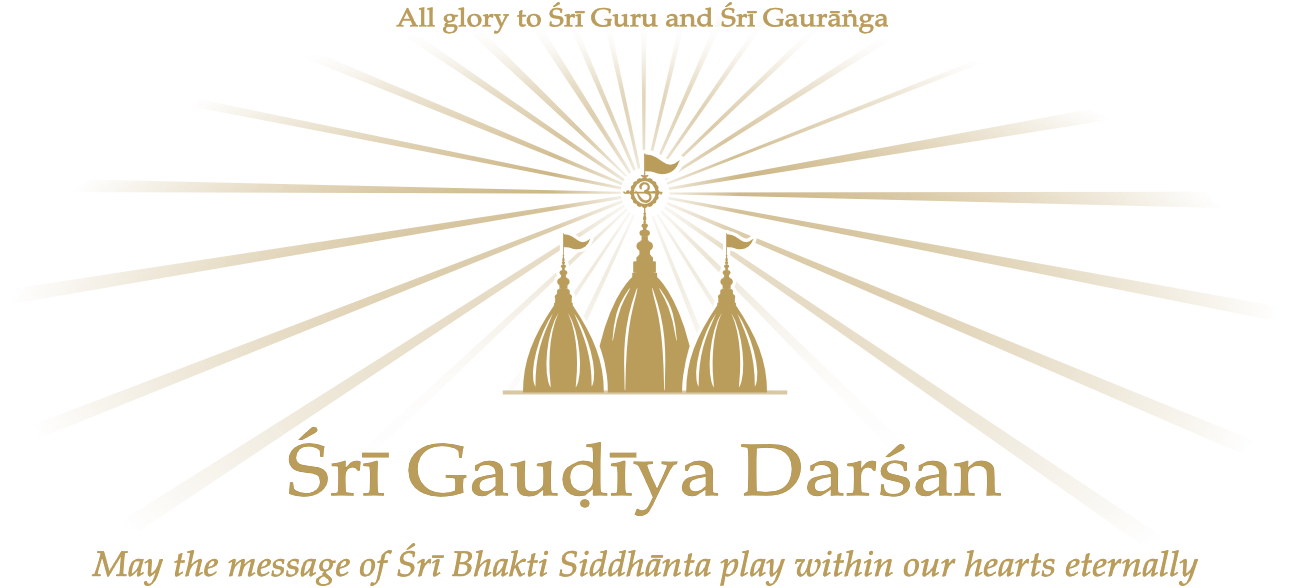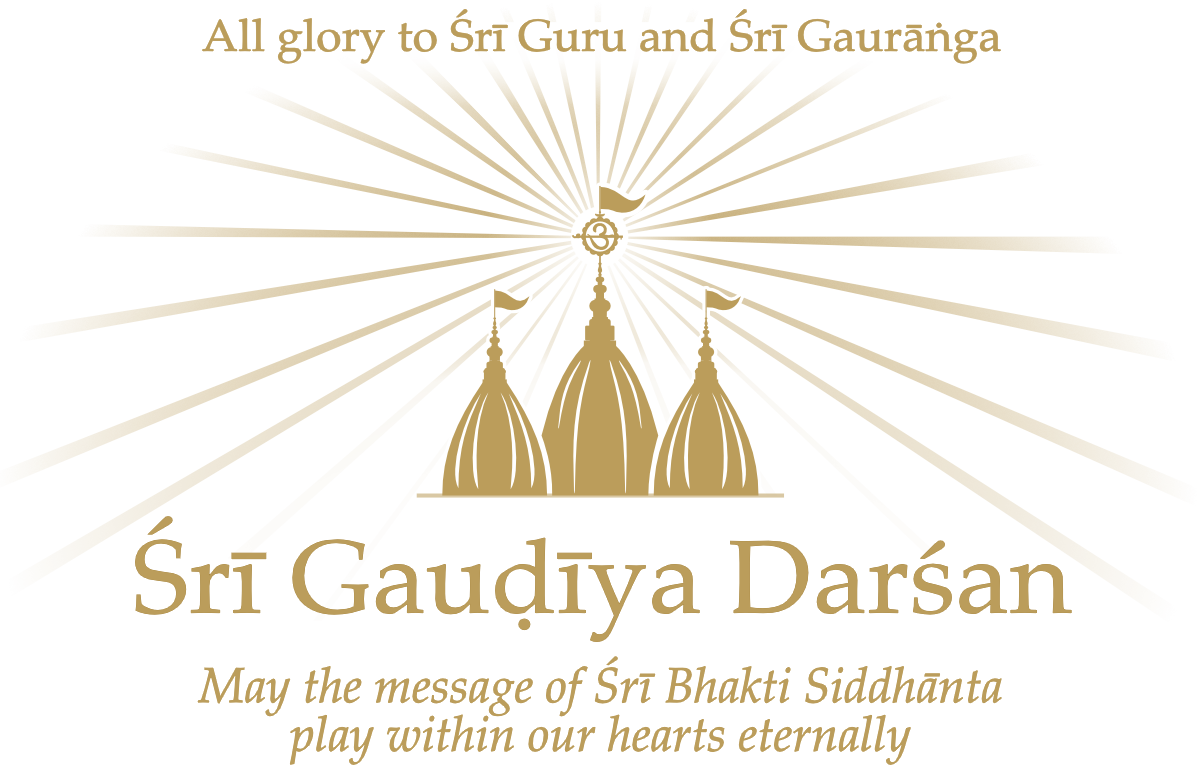Śrīla Bhakti Sundar Govinda Dev-Goswāmī Mahārāj recounts the glory of Nitāi and Gaurāṅga.
When Śrīla Vṛndāvan Dās Ṭhākur composed Śrī Chaitanya-bhāgavat, he began with this verse:
ājānu-lambita-bhujau kanakāvadātau
saṅkīrtanaika-pitarau kamalāyatākṣau
viśvambharau dvija-varau yuga-dharma-pālau
vande jagat-priya-karau karuṇāvatārau
(Śrī Chaitanya-bhāgavat: Ādi-khaṇḍa, 1.1)
Ājānu-lambita-bhujau kanakāvadātau: Mahāprabhu’s form was very effulgent and had long arms.
pañcha-dīrghaḥ pañcha-sūkṣmaḥ sapta-raktaḥ ṣaḍ-unnataḥ
tri-hrasva-pṛthu-gambhīro dvātriṁśal-lakṣaṇo mahān
(Śrī Chaitanya-charitāmṛta: Ādi-līlā, 14.15)
[“There are thirty-two features of a great personnage: five large—the nose, arms, chin, eyes, and knees; five fine—the skin, fingertips, teeth, hair on the body, and hair on the head;, seven reddish—the eyes, soles, palms, palate, nails, and upper and lower lips; six raised—the chest, shoulders, nails, nose, waist, and mouth, three small—the neck, thighs, and male organ, three broad—the waist, forehead, and chest, and three deep—the navel, voice, and existence.”]
These are the symptoms of a divine personnage, and when Mahāprabhu was born, Nīlāmbar Chakravartī saw all these symptoms in Mahāprabhu’s body. Nīlāmbar Chakravartī calculated His astrological chart at that moment and said, “He is not an ordinary man.” Nīlāmbar Chakravartī understood that Mahāprabhu would take sannyās in future, but He did not mention that. Rather, he said, “He will distribute the Name of the Lord all over the world, and through that, He will maintain the spiritual life of everyone. His divine gift will rescue all the conditioned souls. So, today I am giving His Name as Viśvambhar.” ‘Viśvambhar’ means He who will spiritually maintain everyone all over the world. This Name was in Mahāprabhu’s astrological chart.
Actually, Nityānanda Prabhu and Mahāprabhu are both glorified in this verse. So Viśvambharau means that They both gave full spiritual nourishment and divine knowledge to all the conditioned souls and brought them back to Their own abode, Goloka Vṛndāvan.
Kanakāvadātau: They were both so beautiful looking. They were golden coloured and had tall figures, long arms, and lotus eyes. Kamalāyatākṣau means that the eyes of both Nityānanda Prabhu and Mahāprabhu looked like lotus petals.
Dvija-varau: They were both born in brāhmaṇ families and dvija [‘twice-born’] through initiation.
Saṅkīrtanaika-pitarau: They were the original fathers of saṅkīrtan, and Yuga-dharma-pālau: the maintainers of the dharma for the age. What is the dharma of the age? Saṅkīrtan.
kṛte yad dhyāyato viṣṇuṁ tretāyāṁ yajato makhaiḥ
dvāpare paricharyāyāṁ kalau tad dhari-kīrtanāt
(Śrīmad-Bhāgavatam: 12.3.52)
In the Age of Satya, meditation on Nārāyaṇ was the dharma, and the mahāmantra was,
nārāyaṇa-para vedā nārāyaṇa-parākṣarāḥ
nārāyaṇa-parā muktir nārāyaṇa-parā gatiḥ
In the Age of Tretā, the dharma was sacrifice, and the mantra was,
rāma nārāyaṇānanta mukunda madhusūdana
kṛṣṇa keśava kaṁsāre hare vaikuṇṭha vāmana
In the age of Dvāpar, the dharma was worship, and the mantra was,
hare murāre madhu-kaiṭabhāre
gopāla govinda mukunda saure
yajñeśa nārāyaṇa kṛṣṇa viṣṇo
virāśrayaṁ māṁ jagadīśa rakṣa
In the Age of Kali, the dharma is saṅkīrtan, and the mantra is,
hare kṛṣṇa hare kṛṣṇa kṛṣṇa kṛṣṇa hare hare
hare rāma hare rāma rāma rāma hare hare
One devotee wrote:
nāhi yāga yoga tāpa bhūta-śuddhi nyāsa japa
nāhi puraścharaṇa vidhāna
bhuvane vidita yaśa kevala bhakata vāsa
bhakata-vātsala bhagavān
Worship, sacrifice, meditation, austerities, purificatory rites, invocations, mantra repetition, preparatory rites—none are as fruitful as Hari-kīrtan.
kaler doṣa-nidhe rājann asti hy eko mahān guṇaḥ
kīrtanād eva kṛṣṇasya mukta-bandhaḥ paraṁ vrajet
(Śrīmad Bhāgavatam: 12.3.51)
When the Age of Kali increases, there is so much sin, and the environment becomes very inauspicious. We see so many faults, sins, and inauspicious things in this Age of Kali. At this time, other religious and pious activities are not so effective. Only the transcendental vibration form of our Lord can work at this time. It descends, and fortunate souls can receive that mantram in their hearts. That mantra can be chanted or meditated on anywhere. There are no rules, regulations, or restrictions. It is not that we should chant it at one time and not at another; we should always chant the mantra. Through saṅkīrtan of the Lord’s Name, we will very easily get liberation, and after liberation, we will get a service position in our Lord’s abode. It is only necessary to connect with Hari-nām-saṅkīrtam. It is like an elevator, and it will take us up. It is not necessary to take the stairs. This mantra alone can rescue all the conditioned souls from this illusory environment .
Yuga-dharma-pālau: Nityānanda Prabhu and Mahāprabhu came and gave this consciousness to all the conditioned souls and rescued all the souls who were present during Their time in this world.
Vande jagat priya-karau karuṇāvatārau: They both are always very merciful to the conditioned souls and always doing good for the conditioned souls.
This is the meanings of the praṇām mantra for Nitāi-Chaitanyadev. Śrī Chaitanya-bhāgavat started in this way, glorifying Nityānanda Prabhu and Mahāprabhu.



Leave a Reply